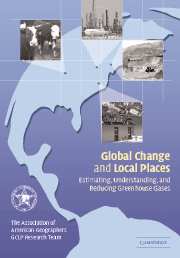Book contents
- Frontmatter
- Contents
- List of contributors
- Foreword
- Preface
- Acknowledgments
- Part One Global change and local places
- 1 A grand query: how scale matters in global change research
- 2 The research strategy: linking the local to the global
- Part Two Learning from localities
- Part Three Beyond Kyoto I: greenhouse gas reduction in local places
- Part Four Beyond Kyoto II: greenhouse gas reduction potentials and strategies
- Index
- References
2 - The research strategy: linking the local to the global
Published online by Cambridge University Press: 31 July 2009
- Frontmatter
- Contents
- List of contributors
- Foreword
- Preface
- Acknowledgments
- Part One Global change and local places
- 1 A grand query: how scale matters in global change research
- 2 The research strategy: linking the local to the global
- Part Two Learning from localities
- Part Three Beyond Kyoto I: greenhouse gas reduction in local places
- Part Four Beyond Kyoto II: greenhouse gas reduction potentials and strategies
- Index
- References
Summary
In the beginning …
The Global Change and Local Places project of the Association of American Geographers originated in a 1992 meeting at which participants formulated three propositions:
The grand query regarding the ways scale matters in understanding global climate change would benefit from detailed case studies of localities that were linked to scholars active in climate change-related research at global and national scales;
Such case studies could constitute a basis for designing a research protocol for use in other local case studies, thereby helping build a body of empirical research that could serve as a basis for developing a bottom-up paradigm for global climate change research to complement the dominant top-down paradigm; and
These locality studies should be based at universities whose faculty possessed detailed, long-term knowledge of their local areas, in some cases engaging scholars in global change research who might otherwise not normally participate in a large-scale research project.
Funding for the project outlined at the 1992 meeting was sought and eventually obtained from the National Aeronautics and Space Administration's Mission to Planet Earth Program (subsequently renamed Destination Earth). Intensive work on the project began in 1996 and continued through 2001. The several rounds of proposal writing that preceded funding refined the theoretical rationale for the project and its central components: four study areas located in Kansas, North Carolina, Ohio, and Pennsylvania; and three cross-cutting modules devoted respectively to estimating local greenhouse gas emissions, understanding the forces driving those emissions, and assessing local emission reduction potentials.
- Type
- Chapter
- Information
- Global Change and Local PlacesEstimating, Understanding, and Reducing Greenhouse Gases, pp. 27 - 54Publisher: Cambridge University PressPrint publication year: 2003

